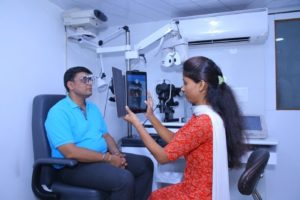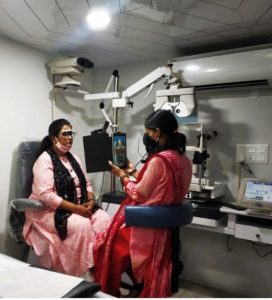

Sports, water activities and all types of outdoor recreation depend upon top visual skills. In addition to crisp eyesight, you need excellent depth perception, eye-hand coordination and peripheral awareness. Our optical technicians will match you to the best specialized eyewear in Buckhead. Whether you play racquetball, go SCUBA diving or spend your leisure time hunting, our eye care team will examine your vision and recommend the most appropriate eyewear.
With consideration for your particular sport or hobby, our eye doctors will customize your eye exam at Smayak Eye Care Clinic. We may use tests to inspect your vision while in motion outside, or while you’re interacting with other objects or players. Computerized exams with 3D, holographic images are very helpful, as well as automated testing that measures your reaction time.
At Samyak Eye Care Clinic we offer an extensive selection of specialty eyewear, and you may need more than one pair of eyeglasses to suit all of your requirements! In addition to safety glasses for sports, we also feature eyewear to protect your eyes from extended computer use. Driving glasses, designed with polarized lenses to diminish glare, are another popular item. Customized tints are also available to enhance contrast for sharp vision in all weather conditions. If your occupation involves hazardous work, such as using power tools, we have a variety of safety eyewear to recommend.
Whatever your sport or hobby, make sure that you are protecting your eyes and achieving optimal performance with the right pair of specialty eyewear. Contact us today near Buckhead to set up a specialty eyewear consultation.
Specialty Eyewear Overview
Glasses for All Seasons, for All Reasons Just as “one-size-fits-all” doesn’t always fit, neither does one pair of eyeglasses for all situations.
Whether you want optimum vision and comfort for a specific activity, such as computer use, work, hobbies or driving, or you need glasses that provide an extra margin of safety for work or recreation, special-purpose eyeglasses will usually meet these needs better than your “everyday” glasses.
Crutch Glasses
Ptosis crutches (also known as eye crutches) are a non-surgical solution to ptosis, also known as drooping eyelid syndrome. Affected eyes do not have the ability to open and close properly. In severe cases, a person is not able to open the affected eyelid. Ptosis eye crutches are tools installed to existing eyewear that support the affected eyelid, enabling the eyelid to stay open and allowing an individual to see.




Computer glasses
Reading and hobbies
If you wear bifocals, you may find you have to tip your head back slightly to use the reading portion of the lens. That’s fine for most things, but if you want to sit and read a novel, this head-back posture can cause neck discomfort and fatigue. Often, a pair of single vision reading glasses are a much better solution for prolonged reading and other detailed near vision tasks, such as sewing or needlepoint work.
Working in the yard or with power tools
Sports eyewear
Did you know that wearing specially-tinted eyeglass lenses can improve your visual acuity on the tennis court, golf course or on the slopes? Sport-specific eyewear can enhance performance by improving visual clarity while protecting your eyes from injury.
Driving glasses
Driving glasses come in two different categories: sunglasses designed specifically for driving and clear prescription driving glasses. Many sunglasses made for driving feature polarized lenses to reduce glare and special tints to enhance contrast for safer, more comfortable vision on the road on sunny days. Eyeglasses for night driving should include your distance prescription and anti-reflective (AR) coating to reduce the glare from streetlights and oncoming headlights and allow more light to reach your eyes for better vision on dark roadways.
We can help
Nearly everyone can benefit from specialty eyewear. Let us know about all the different things you like to do, and we can tell you about the best special-purpose eyewear to fit your needs.
Today, sports eyewear can be spotted on almost anyone who picks up a ball, bat, racquet or stick – whether they play in the major leagues or the Little League. Fortunately, coaches, parents and players now realize that wearing protective eyewear for sports pays off in several ways. The risk of eye damage is reduced or eliminated, and the player’s performance is enhanced by the fact that they see well. In fact, many clubs today do not permit their members to participate without wearing proper eye gear.
Initially, there was some resistance by children to “looking funny” when they wore protective eyewear. Today, sports goggles are an accepted part of everyday life, much the way bike helmets have become the norm. In addition, both children and adults like the image that wearing protective eyewear gives them: it shows they mean business on the playing field.
If you’re not wearing protective eyewear, consider this…
Prevent Blindness America reports that hospital emergency rooms treat 40,000 eye injuries every year that are sports-related. Sports such as racquetball, tennis and badminton may seem relatively harmless, but they involve objects moving at 60 miles per hour or faster. During a typical game, a racquetball can travel between 60 and 200 miles per hour. Another potential danger is that the racquets themselves move at high speed in a confined space and often make contact with one another.
Flying objects aren’t the only hazard. Many eye injuries come from pokes and jabs by fingers and elbows, particularly in games where players are in close contact with each other. Basketball, for example, has an extremely high rate of eye injury.
These are great reasons to wear protective eyewear. Another aspect has to do with performance. It used to be common for people with mild to moderate prescriptions to simply participate in sports without wearing their glasses or contacts. But sharp vision is a vital ingredient to performing well in nearly every sport, and participating in sports when you have less than 20/20 vision is counterproductive.
Features to look for
Prescription glasses, sunglasses and even on-the-job industrial safety glasses don’t provide adequate protection for sports use. Sports goggles are made in a variety of shapes and sizes. Some are even designed to fit in helmets used for football, hockey and baseball. Sports goggles should allow the use of helmets when the sport calls for it.
Lenses in sports eyewear are usually made of polycarbonate. Since polycarbonate is such an impact-resistant lens material, it works well to protect eyes from fast-moving objects. Polycarbonate lenses also have built-in ultraviolet (UV) protection and are coated to be scratch resistant – valuable properties for outdoor sports.
Polycarbonate is the material of choice for sports lenses, but the eyewear frame plays just as important a role. Different sports require different types of frames, which has led to development of sport-specific frames. Sport frames are constructed of highly impact-resistant plastic or polycarbonate, and most come with rubber padding to cushion the frame where it comes in contact with your head and the bridge of your nose.
Some sports styles are contoured, wrapping slightly around the face. This type of goggle works well for biking, hang-gliding, and sailing. Contact lens wearers especially benefit from the wraparound style, which shields your eyes from wind and dust.
A note about handball goggles
At one time, handball goggles for those with no need for vision correction were simply goggles with small openings in place of lenses. It was eventually recognized that the high speed of handballs compressed the ball enough to protrude through the opening and cause serious eye damage. All goggles worn for handball and racquetball should include impact-resistant polycarbonate lenses for adequate protection during these sports.
Important fitting considerations
Sport goggles must be properly fit to the individual wearer. This is particularly important with children, because there is a temptation to purchase a larger goggle than what is needed today so the youngster has “room to grow.” Some growing room is acceptable, since sports goggles are made to be somewhat flexible in their width adjustment. If the frames are oversize, however, they will not protect the way they were designed, leaving a potential for damage when there is impact to the head or the face. It’s a risk not worth taking.
By the same token, permitting a youngster to continue wearing goggles that he or she has outgrown can be just as dangerous. First, the frames will be uncomfortable, tempting the child to take them off. Secondly, the frames may obstruct peripheral vision, leading to poor performance with a potential for impact from unseen sources to one side or another. Review the fit of your youngsters’ sports eyewear each year to ensure that they are still providing proper protection and are fitting comfortably. Make sure the padding inside the sides of the goggle rests flush with the face and the eyes are centered in the lens area.
Enjoy sports to the fullest, with no worries about eye safety. Learn more about the benefits of protective sports eyewear for you and your kids.
Eyewear for Swimming, Snorkeling and Scuba Diving
If you need vision correction, participating in swimming and watersports requires an extra bit of planning. You want to see your best both in and out of the water but your regular glasses and contact lenses aren’t feasible options. Well the good news is, there are prescription swimming goggles and masks available to provide optimal vision in the water and here is what you need to know about them.
First of all, many people don’t know about the dangers of wearing contact lenses in the water. Wearing contact lenses in any kind of water, whether it is an ocean, a pool or even a shower, is risky because bacteria in the water could cause an infection if they get under your lens. Unless you are wearing a mask or goggles that are 100% sealed and don’t let any water underneath, wearing contacts in the water is not recommended. If you do decide to wear contact lenses in the water, it is recommended to discard them immediately upon exiting the water.
Prescription Swimming Goggles
A fantastic solution for swimmers is prescription swimming goggles. These are regular swim goggles with either pre-made or a custom made prescriptions lenses. Pre-made lenses will likely not be fit to your exact prescription needs, but if you select them appropriately, they will be adequate for you to see well for swimming and sporting in the water. Custom made goggle lenses will fit your prescription, although they will be slightly different than your regular eyeglass prescription because of the differences in seeing underwater. Whether you are purchasing pre-made or custom made swimming goggles, you should consult with your eye doctor and/or an optician knowledgeable on the topic to make sure you select the optimal lens for your vision needs. If you have astigmatism or another eye condition, you may have additional needs to consider.
Prescription Snorkeling and Scuba Diving Masks
If you scuba dive or snorkel you want to see every detail of the beautiful underwater world. You can achieve this by using a dive mask with a prescription lens. There are a few options for prescription masks. In the first option corrective lenses are bonded or glued to the inside of your mask, creating a second layer. A second option is to purchase a mask in which the entire lens of the mask is replaced with a prescription lens. These can be premade or custom made lenses. There are also now masks that are made with removeable lenses in which you can buy the corrective lens separately and insert it yourself.
You may have to adjust to viewing with a corrective dive mask because the lens might be further from your eyes than you are used to with your regular eyewear.
In general, pre-made prescription lenses on both goggles and masks are cheaper than the custom made options. In most cases, since you are using them for a relatively short period of time, the pre-made options can suffice. If however, you are a serious diver and want to see as clearly as possibly, it may be worthwhile to look into a custom made mask.
The proper spots eyewear will help you see as clearly in the pool and underwater as you do on dry ground.
Shooting Glasses and Hunting Eyewear
- Firearms can be dangerous, and all have some recoil. In addition most shooting occurs outside, where elements such as dust, wind, sun, trees and vegetation can potentially harm eyes. Therefore it’s very important to use eye protection at all times when engaged in shooting activities, indoors and outside.
- Generally, sports goggles that you can buy without prescription usually protect your eyes if you wear contacts or don’t need glasses. These goggles usually wrap around your eyes to form a shield against the elements. Make sure to buy goggles with lenses made of polycarbonate, which is the best and strongest lens material available.
- Features of Shooting Glasses
- Glasses for shooters are specially designed and have several important features. These glasses have more features that the general aviator- shaped frames that are popular. The most important feature is that the frame has a safety rating. Don’t buy any shooting glasses that don’t have such a rating. All of these models have a strong rim which holds the lenses in place. Some glasses have a “sweat bar” that goes along the width of the frame which creates stability for the frame to stay on the face. Other models use padding on the frame around the eyes, which cushions the frame on your face. This protects your face from gun recoil. Additionally, it adds to the protection against the elements.
- Glasses for shooting often have temples with spring hinges. This type of hinge allows the frame to move without breaking. Many glasses often include temples that wrap around your ear which helps keep the frame in the correct position on your face. Features that make the frames more comfortable often include soft silicon pads around the nose, which also help to keep the frame in place. Frames may be made out of several different types of materials, including various metals and titanium, plastic and polycarbonate.
- Lenses for Shooting Glasses
- Shooters have chosen polycarbonate lenses with UV protection and a scratch-resistant coating as their lens of choice for years. Polycarbonate lenses are extremely resistant to impact, and also give a lot of “bounce back” and “blow back” protection. However, there are newer materials for lenses that have been developed recently that are also excellent choices for shooters.
- Non-prescription shooting glasses often come with interchangeable lenses. These lenses are used when facing varied conditions of light. If you need prescription lenses, you can order your lenses in various colors of your choice. Shooters often enjoy using orange or yellow colored lenses. These colors of lenses block blue light as well as haze. They also provide a more vivid hue of orange, which is often the color of the target. Bright yellow lenses are good for using in low light, or foggy weather conditions.
- A light purple lens is particularly good for seeing an orange target when the background is green trees. Purple lenses are made from a mixture of vermillion and gray. Some shooters like vermilion, because this color helps see where there is a natural outdoor background, and helps the target to stand out. If you prefer a neutral or natural color, gray is the color of choice. A gray lens allows you to see all colors naturally, and are good for using in strong sunshine.
- Polarized lenses are available in most colors. Polarized lenses are good for use in the outdoors, as they reduce glare. This is particularly helpful when shooting near water.
- Good vision is critical when hunting or using a firearm, so look for the right features when buying “shooting glasses.
Contacts & Glasses that Enhance Performance Sports eyewear does more than just protect your eyes from injury – it offers performance advantages as well.
Every sports activity requires a different skill set for success, yet all sports share a critical need for good vision. Geraint Griffiths, a British optometrist, devised a study to determine the effects of visual acuity on sports performance. This study distributed special vision-blurring goggles to Wimbledon tennis players and UK national clay pigeon shooters. Their performance was studied while the goggles were worn. Even though the goggles only blurred their vision a bit, the marksmen and tennis players showed a 25% decrease in accomplishment. This study demonstrated clearly that vision and sports achievement are inextricably linked.
Visual clarity isn’t the only benefit provided by sports eyewear. There are a number of additional eyewear features that boost athletic performance and enhance eye safety.
Protect Your Eyes from Impact-Related Injuries
As reported by the American Academy of Ophthalmology, over 42,000 sports-related eye injuries occur in the United States each year. Approximately 43% of those injuries happen to children under the age of 15. The majority of these injuries can be prevented with protective eyewear, such as safety goggles with polycarbonate lenses.
Regular eyeglasses are designed for daily wear, and they aren’t resilient enough to handle the rough and tumble wear needed for sports. They also provide inadequate protection for your eyes. Contact lenses offer zero protection from sports-related eye injuries. In contrast, sports eyewear is constructed to be highly impact-resistant, thereby granting superior protection for your eyes and removing anxiety about potential eye injuries. Able to withstand the hit of a ball traveling at up to 90 miles per hour, polycarbonate lenses are about 10 times more impact-resistant than regular lenses.
Safety eyeglasses are advised for every activity that has the potential for injuries to the eye. Be aware that the following land sports run a higher risk to eyes: softball, baseball, hockey, football, basketball, handball, squash, racquetball, tennis, volleyball, soccer and lacrosse. In water, all swimming and pool sports require specialized eye gear. Paintball players should also make safety eyewear an essential part of their game.
A Barrier against UV Rays
Harmful ultraviolet (UV) radiation can be just as damaging to your eyes as other injuries. A number of eye diseases, such as ocular tumors, macular degeneration, and cataracts, have been associated with exposure to UV rays. Photokeratitis, which refers to sunburn on your eye, is another hazard. This painful condition can cause long-term corneal damage.
Dangerous UV rays are more potent at higher altitudes and also bounce off snow or outdoor water, which increases exposure. It is imperative for skiers and anyone who enjoys outdoor water sports to wear sports sunglasses or tinted goggles that block 100% of the sun’s UV rays.
Some types of contact lenses provide UV protection, yet they only cover the central part of your eye. For this reason, sunglasses that block UV rays should still be worn, preferably in a wraparound style that also covers the delicate tissues surrounding your eyes. Hats with a wide brim will upgrade your protection by further reducing facial exposure to UV rays.
Enhance Your Game with Colored Lenses
Special tinted eyewear may add a winning edge to your game. Depending upon the lighting conditions, it’s not always simple to “keep your eye on the ball”. Hunters favor shooting glasses with amber tinted lenses, which highlight the contrast of birds flying against an overcast, dim sky. Golfers tend to gain the largest benefit from green tinted lenses.
A wide range of specialized tints for specific indoor and outdoor sports are available. These lenses can improve visibility and contrast in a diversity of environments. Ask your eye doctor or optician for more information about which lenses can help raise your scores.
Don’t Let Light Get in the Way
Reflective surfaces, such as a flat body of water, a sandy beach or even light-colored pavement, can disturb your vision with glare. Polarized sunglasses are one effective way to resolve this problem.
Another glare reducer is to add and anti-glare (AG) component to your lenses. At night, sports eyewear with anti-glare will diminish lens reflections when playing under bright lights or spotlights. It’s a good idea to apply anti-glare to the back surface of sport sunglasses in order to decrease the glare that bounces into your eyesight when sunlight hits the back of your lenses.
You can control the light that enters your eye by wearing photochromic lenses. These clear lenses transition automatically into dark lenses upon exposure to UV rays. They also offer 100% UV protection, and return quickly to their former clear state when you go indoors.
Contacts Provide Comfortable and Convenient Vision
Many advantages come along with wearing contact lenses for sports, even if you normally wear eyeglasses on a daily basis:
- Unobstructed peripheral vision
- Natural-appearing vision, with no changes in image sizes
- No fogging lenses
- Non-slip when perspiring
The best contact lens choice for sports is soft one-day disposables. There’s no need to clean them and you can toss them in the garbage at the end of the day. The flexible, oxygen-permeable material of one-day soft lenses also requires very little adaptation. They can be inserted easily and worn comfortably for a full day of physical activity.
Although contact lenses offer high convenience and comfort, there are still a number of disadvantages with wearing contacts for sports. No protection against eye injury is provided and they don’t offer sufficient UV protection. For ultimate performance and safety, you need to wear quality protective eyewear or sunglasses over your lenses.

